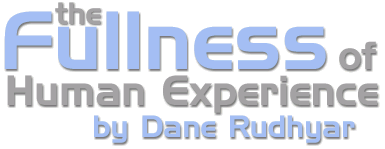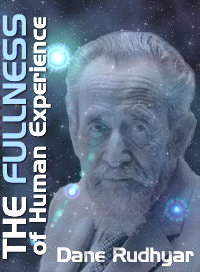 |
| Home | Bio | Art | Music | Literature | Civilization & Culture | Philosophy of Wholeness | Theosophy & Spirituality | Astrology |

CHAPTER NINE
The "Dangerous Forties" in the Life-Cycle of Humanity - 1 The speed of change According to the generally accepted interpretation of recent archaeological and paleontological discoveries, the basic biological structure of what is now homo sapiens began to operate in the earth's biosphere several million years ago. As our modern archaeologists understand the prehistoric development of human races, the new evolutionary capacities inherent in this type of organization have been very slow to manifest. The number of human beings remained very small, and the tribes struggling with one another for survival on several continents did not differ greatly from animal societies. In the latter, a definite and often very strict kind of organization has always been at work, dominated by biological needs and the instincts required for their satisfaction; and various modes of communication should be considered real languages — the language needed and effective at the level of animal consciousness. One of the most basic differences between the human and the animal stage of living and experience may have revealed itself when human beings discovered the various uses of fire, particularly the possibility to use fire to transform materials so as to make them more satisfying. While all animals fear fire, human beings overcame this biologically rooted fear once they realized that the changes produced by fire could be not only welcome but deliberately used to improve human existence and generate a new form of power. After a forest fire, a nearly burnt animal may have shown the value of cooking living organisms, and perhaps the effects of extreme heat on pieces of matter on the ground may have suggested procedure which eventually led to the making of pots, bronze arrows, etc. According to many religious and all occult traditions, however, the use of fire was actually taught by superior Beings, rather than discovered by ordinary men or women. But whether one scenario or another is considered believable, the picture generally accepted by the modern mind refers to a period of millions of years. During this time primitive societies succeeded one another until, some five to six thousand years ago, a clearly marked change occurred and a new type of social organization began to develop. It is impossible to ascertain whether material changes in the conditions of life and new possibilities of interpersonal relationships impelled human beings to operate at a more complex, more differentiated and more inclusive level of organization, or whether the new societies took form because a sufficient number of people had experienced an inner "revolution in consciousness" affecting their personal and group approach to life and the world around them. The simplest answer is that the time had come for the drive toward a radical transformation to operate synchronously at both the societal and the personal-psychological (or psychic) levels, because a critical phase in the relationship of the principles of Unity and Multiplicity had been reached in the evolution of the whole planet. The change was critical in the sense that it induced a crisis of transformation affecting all three basic aspects of human experience. It engendered new types of desires, new modes of energy (more societal than strictly biological), and new procedures for the actualization of the desires. These procedures were needed to cope with, interpret, and justify the subjective eagerness to handle, manage, and intellectually understand the operation of the new energies generated by the complex interpersonal and intergroup relationships developing in relatively large cities in which a centralized kind of power was becoming consolidated. The management of that centralizing power working on the products of human togetherness and social cooperation became the substance of politics and economics. At the psychological-personal level, the centralizing process operates in the formation of an ego which, as we have seen, is the form taken by a human being's ability to adjust the relationships between the many drives of a human organism and complex societal situations in order to insure survival and the actualization of personal desires and ambitions. There are several points in history which should be seen as radical crises of all-human transformation: in ancient Greece, the rise of a rationalistic mind; at the same time in India the development in early Buddhism of an objective approach to the problems of human existence; then, 2,000 years later, European Humanism and the triumph of the empirical and analytical method of science. The changes in the thinking, the everyday activities and the feeling-responses of at least a minority of dynamic human beings representing the spearhead of human evolution have been far-reaching and presumably irreversible. The speed at which they occurred gives them a startling character. Compared to the probable millions of years since the appearance of homo sapiens, the last five millennia, and especially the last two centuries, are mere seconds in the expectable life-span of a biological species. If we believe in the generally accepted Darwinian theory of evolution, what could have generated this sudden development of new or so far only latent mental faculties, and since the early Renaissance the nearly passionate urge to transform human living conditions by means of their application? Why did it not happen before? Was it the result of a basic change in the biosphere or the entire planet — a change more radical than a glacial period? Geologists do not usually base their calculations on some planetary event so far-reaching that it could have affected so rapidly and irrevocably the very foundation of the way in which the human species operates. Was then the relatively sudden change predicated in the structural development of the human organism? We can indeed find a parallel to what the whole of humanity experienced at a historical level if we observe equally rapid periods of development during the life-span of one individual human being. These normal and expectable developments can help us more easily to understand the all-human historical process and what it is meant to achieve. By permission of Leyla Rudhyar Hill Copyright © 1986 by Leyla Rudhyar Hill All Rights Reserved.  Web design and all data, text and graphics appearing on this site are protected by US and International Copyright and are not to be reproduced, distributed, circulated, offered for sale, or given away, in any form, by any means, electronic or conventional. See Notices for full copyright statement and conditions of use. Web design copyright © 2000-2004 by Michael R. Meyer. All Rights Reserved. |
 |
